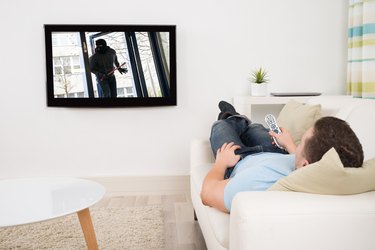
RCA currently specializes in LCD TVs, but they've been in business for many years and have produced a wide variety of models. Troubleshooting your set depends in part upon the particular model you own. Nevertheless, certain features are common across all of them, and you can apply a few basic techniques in order to troubleshoot many minor problems. They're quick to apply and can often spare you the expense of calling a repairman.
Sound Problems
Video of the Day
Sound problems on an RCA can be located in the volume controls. If your sound appears to be unbalanced or you need to tweak the particulars, press the "Menu" button and then select the "Audio" option. From there, you'll be able to select features like the sound equalizer, the audio processor and the Spanish language option. If the number of options confuses you, select "Audio Mode," then set it to the default setting. The RCA TV will automatically adjust the audio to fit the program you're watching. If there's no sound at all, go to the "Audio Processor" option and make sure it's set to the correct mode for your system (usually stereo if you're using the TV's speakers, or SRS if you're using external speakers).
Video of the Day
Picture Problems
Picture problems on an RCA TV can stem from a number of sources. Newer RCA sets allow you to shift the formatting between widescreen and full-screen programming; if your image looks distorted or cut off, press the "Format" button on the remote, or press the "Menu" button, then the "Preferences" menu onscreen, then the "Screen Format" feature. Both allow you to cycle through the various viewing options until the picture looks right. If there's a black box on the screen, you may have inadvertently activated the closed captioning feature. Push the "Menu" button, then go to "Preferences," then "Closed Captioning" to turn it off. Sharpness, color tinting and other visual attributes can be adjusted by pushing the "Menu" button, then selecting the "Picture Quality" option. (Newer RCA TVs have preset options allowing you to correct the color instantly.) And of course, you should always check the connections to your cable box, satellite box or DVD player to make sure the signal is coming in effectively.
Power Problems
Assuming you have exhausted the basic issues regarding power (like making sure the TV is plugged in and receiving power), look to either the TV lamp or any of the TV's various special features to correct the issue. Newer RCA TVs, such as LCDs, use powerful lamps. When you turn off the set, the lamp goes into cool-down mode, and the image won't appear for a few seconds until it warms up again. Pay close attention to the blinking red light in front of the RCA TV. It will blink steadily to let you know the lamp is dead (requiring a replacement lamp), and blink in sequences of five to let you know that the housing containing the lamp has not been closed correctly. If your TV turns on and off unexpectedly, you may have inadvertently set the timer, which you can access and change by pressing the "Menu" button, then the "Time" option.